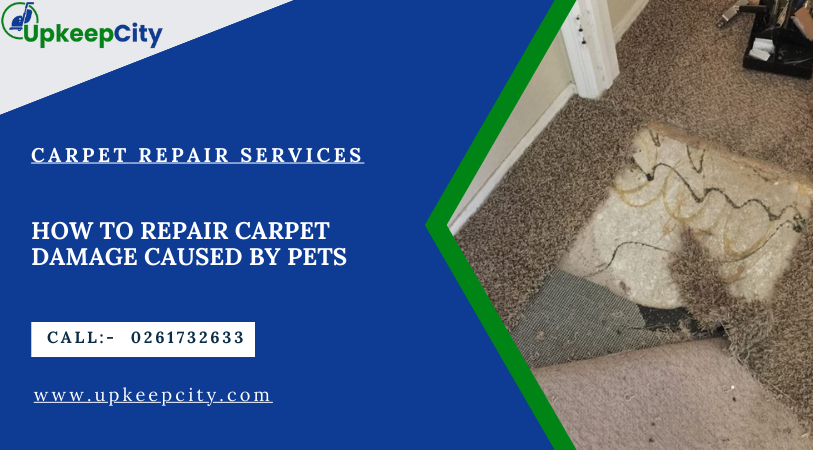How to Repair Carpet Damage Caused by Pets: A Comprehensive Guide
Introduction
Our furry companions bring immeasurable joy and love into our lives, but they can also inadvertently leave their mark on our homes. One common challenge pet owners face is dealing with carpet damage caused by their four-legged friends. Most of the pets ower’s google search history has one search in common that is “How to Repair Carpet Damage Caused by Pets“. From claw marks to stains, pet-related carpet damage can be frustrating. However, fear not! In this comprehensive guide, we’ll walk you through effective steps to repair carpet damage caused by pets and restore your floors to their former glory.
Understanding the Types of Carpet Damage
Before delving into repair strategies, it’s important to understand the different types of damage pets can cause to carpets:
- Claw Marks: Cats and dogs often scratch carpets, leaving unsightly claw marks and frayed fibers. These marks are not only visually unappealing but can also weaken the carpet’s structure over time.
- Stains: Accidents happen. Urine, vomit, and other pet-related stains can seep into the fibres, causing discolouration and odour. If not treated promptly, these stains can lead to long-lasting damage.
- Snags and Tears: Playful pets can cause snags and tears in the carpet, disrupting the overall appearance and creating tripping hazards.
- Chewing and Gnawing: Puppies and young pets may chew on carpet edges or corners, leading to fraying and damage. This type of damage can be particularly challenging to repair.
Step-by-Step Guide How to Repair Carpet Damage Caused by Pets
1. Assess the Damage
Begin by assessing the extent of the damage. Take a close look at the affected areas and the type of damage they’ve suffered. This assessment will help you tailor your repair approach accordingly, ensuring that you address each issue effectively.
2. Trim Loose Fibers
For snags and tears, start by carefully trimming any loose or frayed fibers. Use sharp scissors and ensure you trim the damaged section neatly to prevent further unravelling. This step will help prevent the damage from worsening and create a cleaner canvas for further repairs.
3. Repair Snags and Tears
For larger tears, you might need to patch the damaged area. Cut a patch from an inconspicuous area of the carpet or use a remnant piece if available. Ensure the patch matches the grain and direction of the carpet fibers. Apply carpet adhesive to the patch and carefully press it into the damaged area, aligning the fibers. Gently tamp down the edges to ensure a seamless blend.
4. Address Stains
For urine and other stains, acting quickly is essential. Blot the stain with paper towels to absorb as much moisture as possible. Create a mixture of equal parts water and white vinegar, then gently blot the stain with a clean cloth dipped in the solution. Repeat as needed, gradually lifting the stain. Follow up with a mixture of water and mild dish soap to remove any remaining residue. Be sure to test any cleaning solution in an inconspicuous area first to ensure it doesn’t damage the carpet’s color or fibers.
5. Deal with Odors
Even after removing stains, lingering odours can be a concern. Sprinkle baking soda over the affected area and let it sit for a few hours before vacuuming it up. Baking soda helps neutralize odours, leaving your carpet smelling fresh. For persistent odours, you can also consider using a commercial pet odour neutralizer.
6. Hide Chewing and Gnawing Damage
For small areas with chewing or gnawing damage, consider using a carpet repair kit. These kits often include adhesive and coloured fibers that you can blend with your carpet to hide the damage. Carefully follow the kit’s instructions to achieve a seamless repair.
7. Prevention
Prevention is key to avoiding future carpet damage. Provide your pets with designated scratching posts, toys, and appropriate chewing items. Regularly trim your pet’s nails to reduce the risk of claw marks, and consider using carpet runners or area rugs in high-traffic pet areas to protect your carpet. Additionally, consistent and thorough potty training for puppies can help minimize accidents that lead to stains and odours.
Conclusion
Repairing carpet damage caused by pets requires a blend of patience, diligence, and the right techniques. By carefully assessing the damage, choosing the appropriate repair method, and taking steps to prevent future incidents, you can successfully restore your carpet’s appearance and extend its lifespan. Remember, with a little effort and care, your pets and your carpet can coexist harmoniously in your home. By following these steps, you’ll not only have a beautiful carpet but also a comfortable and pet-friendly living space.
At Upkeepcity, the carpet repair team has the experience, energy, and great attitude toward the carpet who have records for delivering the best result .
Click here to know more about us and Carpet based services based in cities of Australia Carpet Repair Canberra, Carpet Repair Sydney, Carpet Repair Melbourne.
Top Service-Providing Areas in Australia:

Leave a Reply